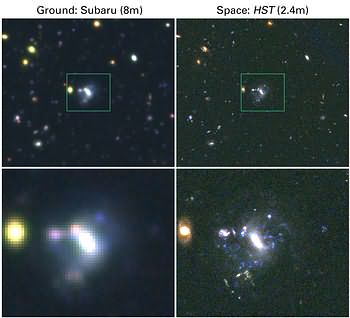
Press Release No.: STScI-2004-07
March 9, 2004
Hubble's Deepest View Ever of the Universe Unveils Earliest Galaxies [Extract]
This historic new view is actually two separate images taken by Hubble's Advanced Camera for Surveys (ACS) and the Near Infrared Camera and Multi-object Spectrometer (NICMOS). Both images reveal galaxies that are too faint to be seen by ground-based telescopes, or even in Hubble's previous faraway looks, called the Hubble Deep Fields (HDFs), taken in 1995 and 1998.
The HUDF field contains an estimated 10,000 galaxies. In ground-based images, the patch of sky in which the galaxies reside (just one-tenth the diameter of the full Moon) is largely empty. Located in the constellation Fornax, the region is below the constellation Orion.
"The images will also help us prepare for the next step from NICMOS on the Hubble telescope to the James Webb Space Telescope (JWST)", Thompson explains. "The NICMOS images reach back to the distance and time that JWST is destined to explore at much greater sensitivity". In addition to distant galaxies, the longer infrared wavelengths are sensitive to galaxies that are intrinsically red, such as elliptical galaxies and galaxies that have red colors due to a high degree of dust absorption.
Though ground-based telescopes have, to date, spied objects that existed just 500 million years after the big bang (at a redshift of 10), they need the help of a rare natural zoom lens in space, called a gravitational lens, to see them. However, the ACS can reveal typical galaxies at these great distances. Even much larger ground-based telescopes with adaptive optics cannot reproduce such a view. The ACS picture required a series of exposures taken over the course of 400 Hubble orbits around Earth. This is such a big chunk of the telescope's annual observing time that Institute Director Steven Beckwith used his own Director's Discretionary Time to provide the needed resources.
TIFF and JPEG images, and press release texts are available via World Wide Web at
Hubble's Deepest View Ever of the Universe Unveils Earliest Galaxies
(HubbleSite - NewsCenter. March 9, 2004)
The Space Telescope Science Institute is operated by the Association of Universities for Research in Astronomy, Inc. (AURA), for NASA,
under contract with the Goddard Space Flight Center, Greenbelt, MD.
The Hubble Space Telescope is a project of international cooperation between NASA and the European Space Agency (ESA).
Updated: March 11 '04
Best seen with MS Internet Explorer.
Back: Observatorio ARVAL - Hubble Ultra Deep Field
Messages: